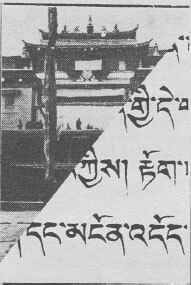| The following article is from the Winter, 1992 issue of the Snow Lion Newsletter and is for historical reference only. You can see this in context of the original newsletter here. |

TRANSLATING BUDDHISM FROM TIBETAN: AN INTRODUCTION TO THE TIBETAN LITERARY LANGUAGE AND THE TRANSLATION OF BUDDHIST TEXTS FROM TIBETAN by Joe B. Wilson, Jr.
Written for beginners, but with material of interest to advanced students as well, Translating Buddhism from Tibetan presents Tibetan in a systematic and structured way. It begins with rules for reading, writing, and pronouncing Tibetan, gradually carrying the reader through the patterns seen in the formation of words, and into the repeating patterns of Tibetan phrases, clauses, and sentences. Based on the methods of teaching Tibetan originally developed by Jeffrey Hopkins at the University of Virginia, this book balances traditional Tibetan grammar and syntax with a use of terminology that reflects English preconceptions about sentence structure.
Translating Buddhism from Tibetan is unique in its approach to Tibetan grammar and syntax. The author, who began studying Tibetan in 1969 and translating Buddhist texts in the early 1970s, has discarded the traditional Latin-and Sanskrit-based categories for analyzing and explaining Tibetan, and has developed an approach to learning and translating Buddhist Tibetan based on identifying repeating patterns in phrases and sentences. After five years of teaching Tibetan at the University of Virginia, the author spent another five years examining Tibetan Buddhist literature and developing this pattern-based approach to Tibetan grammar.
The patterns in Tibetan phrases, clauses, and sentences are presented and analyzed in Translating Buddhism from Tibetan in an easy-to-understand, diagrammed form. Boxes and arrows are used to illustrate the flow of ideas and the relationship between words in Tibetan sentences.
Translating Buddhism from Tibetan is also unique in having an approach which focuses on the vocabulary seen in Buddhist texts, especially those dealing with philosophy and meditation. It provides the student with the vocabulary basic to a wide variety of Tibetan texts, as well as the special terminology and patterns used in Buddhist logic, essential for reading many philosophical works. The author's twenty years of experience with Tibetan Buddhist philosophy is reflected in the book's constant search for patterns in this area as well.
Translating Buddhism from Tibetan thus operates on a number of levels. It provides analysis and instruction in the phonemic dimension of Tibetan (the pronunciation of letters, syllables, and words). In the lexical dimension, it seeks to provide the student with a grounding in basic Buddhist vocabulary. In the syntactic dimension, it classifies everything on a Tibetan page into words, syntactic particles, and case marking particles and presents in diagrammed form the patterns that occur with the various classes of verbs. In the conceptual dimension, it expands the student's understanding of vocabulary to encompass the definitions and categories of important terms, knowledge presupposed in a reader by the authors of Tibetan texts. In the rhetorical dimension, it presents and analyzes the patterns seen in larger sturctures (those consisting of many clauses or many sentences).
About the Author
Joe. B. Wilson, Jr. has, for most of his adult life, either lived or studied with Tibetan speakers. He began study of Tibetan at the University of Wisconsin in 1969, from which he received a B.A. in 1971 and an M.A. in 1973. From 1973 to 1975 he lived and worked (as a translator) at what is now the Tibetan Buddhist Learning Center in Washington, New Jersey. In 1976 he entered the graduate program in Buddhist Studies at the University of Virginia, receiving a Ph.D. in 1984. While there, he taught Tibetan language and Buddhist philosophy and has served as interpreter for a number of Tibetan lamas. Although most of his teachers have been Geluk or Nyingma, he considers himself to be ecumenical in his approach and has written Translating Buddism from Tibetan in that spirit. Since 1985, the author has been a member of the faculty of the University of North Carolina at Wilmington.
540 pages
$45 Cloth
Snow Lion

DEBATE IN TIBETAN BUDDHISM
by Daniel Perdue
The practice and theory of introductory Buddhist logic and epistemology, as found in Tibetan Buddhism, is the focus of this clear and thorough exposition. An essential prerequisite in Tibetan philosophical studies is ascertainment of the procedure in debate, for debate is the investigative technique used throughout Tibetan education to lead students into Buddhist philosophy and to increase their sharpness and analytical capacities. Also, since a significant part of the Tibetan commentarial tradition incorporates the debate style as the principal means of explaining philosophy, in order to understand the various philosophical stances in Tibetan religious studies it is essential to apprehend the procedure in debate.
This volume takes as its basis a translation of The Introductory Path of Reasoning (Rigs lam chung ngu) in THE PRESENTATION OF COLLECTED TOPICS REVEALING THE MEANING OF THE TEXTS ON VALID COGNITION, THE MAGICAL KEY TO THE PATH OF REASONING (Tshad ma'i gzhung don 'byed pa'i bsdus grva'i rnam bzhag rigs lam 'phrul gyi lde mig), composed by Pur-bu-jok Jam-ba-gya-tso (Phur-bu-jok Byams-pa-rgya-mtsho, 1825-1901). Using this debate manual as its focus, this foundational book covers content and procedure in beginning debate and contextualizes this technique with a view toward its educational efficacy and religious significance. The translation is supplied with annotations on procedure and content drawn from the oral explanations of Tibetan teachers expert in debate. Besides comparatively reporting Tibetan traditions, the final section of the work relates the Tibetan system to the categorical logic of Aristotle, explicates the logic through the use of Euler diagrams, and describes the predication theory implied in the Tibetan debate manuals through the use of John Stuart Mill's theory of naming.
1,025 pages
$38.95 paper $45 Cloth
Snow Lion

